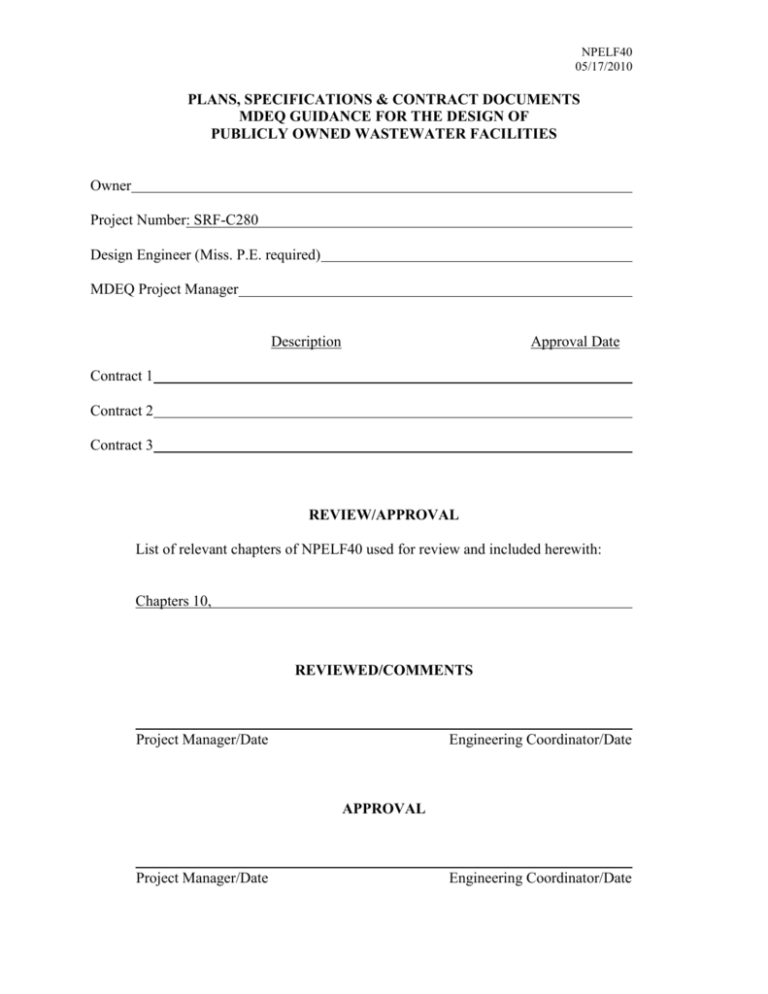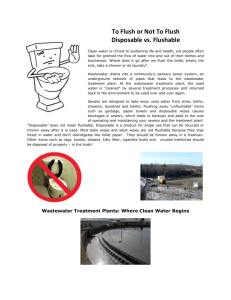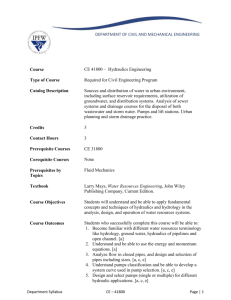CHAPTER 10
advertisement

NPELF40 05/17/2010 PLANS, SPECIFICATIONS & CONTRACT DOCUMENTS MDEQ GUIDANCE FOR THE DESIGN OF PUBLICLY OWNED WASTEWATER FACILITIES Owner Project Number: SRF-C280 Design Engineer (Miss. P.E. required) MDEQ Project Manager Description Approval Date Contract 1 Contract 2 Contract 3 REVIEW/APPROVAL List of relevant chapters of NPELF40 used for review and included herewith: Chapters 10, REVIEWED/COMMENTS Project Manager/Date Engineering Coordinator/Date APPROVAL Project Manager/Date Engineering Coordinator/Date NPELF40 05/17/2010 TABLE OF CONTENTS CHAPTER 10 GENERAL 10. Introduction 11. General Contract Documents (for WPCRLF projects only) 12. Plans 13. Specifications 14. Operation During Construction 15. Storm Water Permitting Requirements 20 DESIGN OF CONVENTIONAL GRAVITY SEWERS 21. Design Capacity 22. Design Flow 23. Details of Design and Construction 24. Manholes 25. Inverted Siphons 26. Sewers in Relation to Streams 27. Aerial Crossings 28. Protection of Water Supplies 29. Sewer Rehabilitation 20A DESIGN OF ALTERNATIVE SEWERS 21A Definition 22A References 23A Design 30 SEWAGE PUMPING STATIONS 31. General 32. Design 33. Suction Lift Pumps 34. Submersible Pump Stations 35. Alarm Systems 36. Emergency Operation 37. Force Mains 40 SEWAGE TREATMENT WORKS 41. Plant Location 42. Quality of Effluent 43. Design 44. Plant Details 45. Plant Outfalls 46. Essential Facilities 47. Safety 48. Laboratory 49. Fire Protection NPELF40 05/17/2010 CHAPTER 50 SCREENING, GRIT REMOVAL, AND FLOW EQUALIZATION 51. Screening Devices 52. Grinding/Shredding (GS) Equipment 53. Grit Removal Facilities 54. Preaeration 55. Flow Equalization 60 SETTLING 61. General Considerations 62. Design Considerations 63. Sludge and Scum Removal 64. Protective and Service Facilities 70 SLUDGE HANDLING AND DISPOSAL 71. Design Considerations 72. Sludge Thickeners 73. Anaerobic Sludge Digestion 74. Aerobic Sludge Digestion 75. Sludge Pumps and Piping 76. Sludge Dewatering 77. Municipal Sludge Disposal on Land 78. Sludge Lagoons 79. Other Sludge Disposal Methods 80 BIOLOGICAL TREATMENT 81. Trickling Filters 82. Activated Sludge 83. Rotating Biological Contactors 90 DISINFECTION 91. Forms of Disinfection 92. Feed Equipment 93. Chlorine Supply 94. Ozone Generation 95. Piping and Connections 96. Housing 97. Respiratory Protection 98. Application of Chlorine or Ozone 99. Evaluation of Effectiveness 99A. Dechlorination 99B. Ultraviolet Disinfection NPELF40 05/17/2010 CHAPTER 100 WASTEWATER TREATMENT PONDS (LAGOONS) 100. General 101. Supplement to Engineer's Report 102. Location 103. Basis of Design 104. Pond Construction Details 105. Miscellaneous 110 SUPPLEMENTAL TREATMENT PROCESSES 111. Phosphorus Removal by Chemical Treatment 112. High Rate Effluent Filtration 113. Intermittent Sand Filtration 114. Microscreening 115. Post Aeration 120 LAND APPLICATION OF WASTEWATER 121. References 122. Overland Flow Systems 130 CONSTRUCTED WETLANDS 131. Introduction 132. References 133. Design NPELF40 05/17/2010 CHAPTER 10 GENERAL 10. INTRODUCTION 10.1 Acknowledgment The technical guidance in this document has primarily been taken from Recommended Standards for Wastewater Facilities 1990 Edition ("Ten States' Standards"). The Department gratefully acknowledges the Great Lakes - Upper Mississippi River Board of State Sanitary Engineers for allowing the use of the Board's guidance. 10.2 Applicability This document, Guidance for the Design of Publicly Owned Wastewater Facilities ("Guidance"), should be used as a guide in the design and preparation of plans and specifications for publicly owned wastewater facilities, insofar as this guidance is applicable to normal situations for an individual project. Plans, specifications, and contract documents should conform to the applicable items in the Guidance, whether or not the facilities receive funding from a Water Pollution Control Revolving Loan Fund (WPCRLF). This document is not a regulation or a standard and has therefore not been adopted by the Commission on Environmental Quality. However, owners, consulting engineers, and other parties involved in the construction of any wastewater collection or treatment facility in the State should be aware of, and must comply with, the Commission's "Wastewater Regulations for National Pollutant Discharge Elimination System (NPDES) Permits, State Operating Permits, Water Quality Based Effluent Limitations and Water Quality Certification (Wastewater Regulations)", and all other applicable laws and regulations. This guidance does not supersede any other existing laws, ordinances, regulations, or standards. If such conflicts arise, the designer should contact the Department and the other appropriate agencies for instruction on how to proceed. It should be recognized that simply complying with the items herein does not ensure that a design is correct, or even adequate, but only minimally acceptable to the Department. High quality projects will routinely exceed the minimum standards stipulated herein, and such quality will likely be reflected in the performance, value and satisfaction obtained from such a design. Further, the Department neither warrants nor assumes any responsibility for any design of any project governed by this Guidance. It is the owner's and/or design engineer's responsibility to ensure that such project designs and specifications are correct and adequate. Should anything contained herein appear to conflict with good design practice, such instance should be brought to the Department's attention immediately for resolution. Plans, specifications and contract documents that vary from this guidance may be submitted and approved (as specified by applicable regulations) when properly justified by the consulting engineer and/or supported by reference to Metcalf and Eddy, WPCF manuals of practice, EPA publications, or other appropriate publications. Although the words "shall" and "must" are used extensively, they are to be interpreted in the context of this section (10.2 Applicability) of the Guidance. NPELF40 05/17/2010 It is recognized that this Guidance does not completely address every conceivable situation concerning the design, inspection, testing, or contracting of publicly owned wastewater facilities construction. Therefore, when any issue arises which is not explicitly covered by the Guidance, the Department may require additional documentation or justification of the reasonableness or adequacy of the plans, specifications and contract documents. The Department may withhold completion of review or approval until such documentation, justification, or document changes are submitted and determined acceptable. Any revisions, changes, addenda, etc. to reviewed and/or approved plans or specifications shall also be made in accordance with this section. Such revisions shall be submitted to the Department for review and approval. If such is by change order, see the Department's guidance and checklist for change order review, in addition to this document. Record drawings clearly showing such alterations shall be submitted to the Department at the completion of the work. Many of the non-technical items in the Guidance apply only to facilities that receive funding from the Water Pollution Control Revolving Loan Fund. WPCRLF-only review items are contained in Section 11 or are identified with an asterisk (*). These items may also be used, but will not be reviewed by the Department, on non-WPCRLF projects. In all cases, Chapter 10 of this document shall be applied. Other chapters shall be used as applicable to the particular project, and shall be listed on the title sheet of this Guidance. *11. GENERAL CONTRACT DOCUMENTS Section 11 applies to WPCRLF projects but may not apply to non-WPCRLF projects. ___ Check to see that all items required in "Required Contract Document Provisions" (NPESRF75) are included. ___ Check to see that the required "Supplemental General Conditions" (NPESRF77) are included. ___ Check to see that specific funding year supplementary conditions are included (example of potential conditions - Davis-Bacon Supplementary Conditions). 11.1 Biddability and Constructability ___ a. All bid items shall be covered by an appropriate measurement and payment paragraph and vice versa. ___ b. Divide total requirements, when economically feasible, into small tasks or quantities to permit maximum participation of minority and women’s businesses. ___ c. Quantities shown on the plans shall agree with those listed on the bid form. ___ d. All requirements shall be clear and concise. ___ e. All work shall require methods and materials which, insofar as practical, NPELF40 05/17/2010 appear to be cost effective, logical, and reasonably accomplishable by a competent contractor. ___ f. 11.2 There shall be no conflicts or confusion between the plans and the specifications or any sections thereof. WPCRLF Eligibility ___ Are all bid items eligible in accordance with Appendix A of the WPCRLF Regulations? ___ If not, are they clearly separated and labeled as ineligible? 11.3 Comparison of Facilities Plan to Plans and Specifications The quantities in the plans and specifications must generally agree with the facilities plan. Facilities Plan Plans and Specifications Gravity Sewer Lines Size, in. Length, ft. Size, in. Length, ft. Force Mains and Pressure Sewers Size, in. Length, ft. Size, in. Length, ft. Location or ID Number Capacity, gpm @ TDH Pumping Stations Location or ID Number Capacity, gpm @TDH NPELF40 05/17/2010 Treatment Units Description, Size, Etc. Description, Size, Etc. Other 11.4 Environmental Impact and Other Submittals a. Have adequate provisions have been made for minimizing erosion during construction? ( ) YES ( )NO b. Does the facilities plan or FONSI require mitigative measures or special construction methods? ( )YES ( )NO If yes, list them and indicate whether they are included in the plans/specs. c. Have proper buffer zones and/or waivers been provided? ( )Yes ( )No ( ) NA d. Has all real property been secured in accordance with the requirements of WPCRLF Regulation III.D.(2)(c)(iv)? ( )Yes ( )No ( )NA e. Has a solid waste disposal permit been issued? ( )Yes ( )NO ( )NA f. Has an NPDES or state operating permit been issued? ( )Yes ( )No ( )NA The permit(s) must be issued prior to approval of P/S for treatment facilities unless allowed by CB (WPCRLF) or EPD (Non-WPCRLF) Chief. NPELF40 05/17/2010 g. Do the discharge point and design flow shown on the plans match the point and flow used to determine the WLA? ( )Yes ( )No ( )NA h. Do the discharge point and design flow on the plans match the point and flow in the facilities plan? ( )Yes ( )No ( )NA 11.5 Flood Information Unit Minimum Design Elev., ft. 100-yr. Flood Elev., ft. Treatment Plant Pump Station(s) a. Are all units operational and not subject to inundation during a 100-yr. flood? ( )Yes ( )No b. Will the project affect a designated flood plain? ( )Yes ( )No If so will E.O. 11988/12148 be followed (mitigation of effect of the project on the Floodplain, FEMA comments)? ( )Yes ( )No ( )N/A NPELF40 05/17/2010 12. PLANS 12.1 General ___ All plans shall bear a suitable title showing the name of the owner, whether a municipality, district, association, or institution. They shall show the scale in feet, a graphical scale, the north point, and date. The plans shall be signed, sealed, and dated by the Mississippi Registered Professional Engineer responsible for their development in a manner consistent with the requirements of the State Board of Registration for Professional Engineers and Land Surveyors, as they apply generally to the practice of engineering. Nothing herein is to be construed as allowing any such work to be performed other than by or under the direct supervision of a Registered Mississippi Professional Engineer. ___ The plans shall be of professional quality, clear and legible (suitable for microfilming). They shall be drawn to a scale that will permit all necessary information to be plainly shown. Generally, the plans should be full size, but not larger than 30 inches x 42 inches. Datum used should be indicated. Locations and data of test borings and wells, when made, shall be shown on the plans. ___ The plans for wastewater treatment facilities shall include a drawing which shows adjacent zoning, the surrounding property lines and that the required 150 foot buffer zone will exist for facilities with wastewater permits. The buffer zone is not required where the adjoining property is zoned or used for commercial or industrial use, or for collectors, interceptors, or pump stations, or where written waivers from affected property owners are submitted and a variance is granted by the Permit Board. ___ Detail plans shall consist of: plan views, elevations, sections and supplementary views which, together with the specifications and general layouts, provide the working information for the contract and construction of the facilities. They shall also include: dimensions and relative elevations of structures, the location and outline form of equipment, location and size of piping, water levels, and ground elevations. 12.2 Plans of Sewers 12.2.1 General Plan A complete plan of existing and proposed sewers shall be submitted for projects involving new sewer systems and additions to existing systems. Plans and specifications for service lines and connections only, or for simple rehabilitation/replacement of existing, previously approved sewers need not be submitted unless required under the WPCRLF program. Combined sanitary and storm sewers are not allowed. This plan shall show the following: NPELF40 05/17/2010 12.2.1.1 Geographical Features ___ a. Topography and elevations - Existing or proposed streets and all ditches, streams, rivers and water surfaces shall be clearly shown. Contour lines at suitable intervals should be included. ___ b. Boundaries - The boundary lines of the municipality or the sewer district and the area to be sewered shall be shown. 12.2.1.2 ___ Sewers The plan shall show the location and size of all existing and proposed sanitary sewers draining to the treatment works concerned. 12.2.2 Detail Plans ___ Detail plans shall be submitted. Profiles should have a horizontal scale of not more than 100 feet to the inch and a vertical scale of not more than 10 feet to the inch. Plan views should be drawn to a corresponding horizontal scale and preferably be shown on the same sheet. Plans and profiles shall show: ___ a. Location of streets and sewers. ___ b. Line of ground surface; size, material and specified type(s) of pipe; length between manholes; invert and surface elevation at each manhole; and grade of sewer between each two adjacent manholes. (All manholes shall be numbered or otherwise identified.) Where there is any question of the sewer being sufficiently deep to serve any user, the engineer shall state that all sewers are sufficiently deep to serve adjacent users without back-ups of wastewater into the residence or business and without problems related to insufficient gravity flow from the residences/businesses. ___ c. Locations of all special features such as inverted siphons, concrete encasements, elevated sewers, etc. ___ d. All known existing structures and utilities, both above and below ground, which might interfere with the proposed construction, particularly water mains, gas mains, storm drains, and telephone, TV and power conduits. ___ e. Special detail drawings, made to scale to clearly show the nature of the design, shall be furnished to show the following particulars: All stream crossings with elevations of the stream bed and of normal and extreme high and low water levels. Typical and special sewer joints, connections, etc. NPELF40 05/17/2010 Details of all sewer appurtenances such as manholes, lampholes, inspection chambers, inverted siphons, regulators, tide gates and elevated sewers. 12.3 Plans of Pumping Stations 12.3.1 Location Plan A plan shall be submitted for projects involving construction or revision of pumping stations. This plan shall show the following: ___ a. ___ b. Any municipal, district, association, etc., boundaries within the tributary area. The location of the pumping station and force main, and pertinent elevations. 12.3.2 Detail Plans Detail plans shall be submitted showing the following, where applicable: ___ a. Topography of the site. ___ b. Existing pumping station. ___ c. Proposed pumping station, including provisions for future pumps or ejectors. ___ d. Test borings, wells, and groundwater elevations, where applicable. ___ e. 100-year flood elevation. 12.4 Plans of Treatment Plants 12.4.1 Location Plan ___ A plan shall be submitted showing the treatment plant in relation to the remainder of the system. ___ Sufficient topographic features shall be included to indicate its location with relation to ditches, streams, rivers, and water surfaces and the point of discharge of treatment effluent. 12.4.2 General Layout Layouts of the proposed treatment plant shall be submitted, showing: ___ a. Topography of the site. ___ b. Size and location of plant structures. NPELF40 05/17/2010 ___ c. Schematic flow diagram(s) showing the flow through various plant units, and showing utility systems serving the plant processes. ___ d. Piping, including any arrangements for bypassing individual units. (Materials handled and direction of flow through pipes shall be shown.) ___ e. Hydraulic profiles showing the flow of water, sewage, supernatant liquor, and sludge. ___ f. Test borings, wells, and groundwater elevations, where applicable. 12.5 Detail Plans Detail plans shall show the following: ___ a. Location, dimensions, and elevations of all existing and proposed plant facilities. ___ b. Elevations of high and low water level of the body of water to which the plant effluent is to be discharged. ___ c. Type, size, pertinent features, and operating capacity of all pumps, blowers, motors, and other mechanical devices. ___ d. Maximum hydraulic flow in profile. ___ e. Adequate description of any features not otherwise covered by specifications or engineer's report. 13. SPECIFICATIONS ___ Complete technical specifications for the construction of sewers, water lines, tanks, wells, pumping stations, treatment plants, and all other appurtenances, shall accompany the plans. ___ The specifications shall be signed, sealed, and dated by the Mississippi Registered Professional Engineer responsible for their development in a manner consistent with the requirements of the State Board of Registration for Professional Engineers and Land Surveyors, as they apply generally to the practice of engineering. Nothing herein is to be construed as allowing any such work to be performed other than by or under the direct supervision of a Mississippi Registered Professional Engineer. ___ The specifications accompanying construction drawings shall include, but not be limited to, all construction information not shown on the drawings which is necessary to inform the builder in detail of the design requirements for the quality of materials, workmanship and fabrication of the project. They shall also include: the type, size, strength, operating characteristics, and rating of equipment; allowable infiltration; the complete requirements for all mechanical and electrical equipment, including machinery, valves, piping, and jointing of pipe; electrical apparatus, wiring, instrumentation, and meters; laboratory NPELF40 05/17/2010 fixtures and equipment; operating tools, construction materials; special filter materials, such as stone, sand, gravel, or slag; miscellaneous appurtenances; chemicals when used; instructions for testing materials and equipment as necessary to meet design standards; and performance tests for the completed works and component units. It is suggested that these performance tests be conducted at design load conditions wherever practical. 14. OPERATION DURING CONSTRUCTION ___ Specifications shall contain requirements for keeping existing wastewater or drinking water facilities in operation during construction of the project. Should it be necessary to take existing facilities out of operation, a plan that will avoid or minimize pollution effects on any receiving stream and provide for alternative service for wastewater or drinking water facilities shall be reviewed and approved in advance by the Department and shall be adhered to during construction. 15. STORM WATER PERMITTING REQUIREMENTS Has the Loan Recipient been notified of the Storm Water permitting requirements as outlined below? ( ) Yes ( ) No ( ) NA a. Construction activities where less than one (1) acre of land is disturbed. (No Permit Required) ( ) Yes ( ) No ( ) NA b. Construction activities where more than one (1) acre but less than (5) acres of land is disturbed. A “Small Construction General Permit” is required. The project manager sends the loan recipient a copy of: (a) Small Construction Storm Water General Permit (which includes the notice of intent (NOI)); and, (b) Construction Guidance Manual (for the storm water pollution prevention plan (SWPPP)). ( )Yes ( )No ( ) NA All of these items are also available to the Loan Recipient for download on the MDEQ website www.deq.state.ms.us. Click “permits” in the left column, then click “storm water permits”, then scroll to the bottom of page for the two forms listed above. NOTE: None of the above listed items for small construction general permits need be submitted to MDEQ unless specifically requested. c. Construction activities where (5) acres or more of land is disturbed. A “Large Construction General Permit” is required. The project manager sends the loan recipient a copy of: (a) Large Construction Storm Water General Permit; (b) Large Construction Storm Water NOI; and, (c) Construction Guidance Manual (for the storm water pollution prevention plan (SWPPP)). ( )Yes ( )No ( ) NA NPELF40 05/17/2010 All of these items are also available to the Loan Recipient for download on the MDEQ website www.deq.state.ms.us. Click “permits” in the left column, then click “storm water permits”, then scroll to the bottom of page for the three forms listed above. NOTE: All the above listed items are required to be submitted to the Environmental Permitting Division (EPD) at MDEQ. Coverage will be granted under the large construction general permit once these submittals are determined acceptable by MDEQ Environmental Permitting Division. d. Wastewater treatment facilities designed to treat 1.0 MGD or more also require a “Storm Water Operating Permit”. Project Manger should inform loan recipient of this requirement and refer them to Rickey Terry with MDEQ Environmental Permitting Division. ( )Yes ( )No ( ) NA 16. Other a. Have provisions have been made to prevent sewage bypassing during construction? *See SGC Attachment 1 (a). ( )Yes ( )No ( )NA b. If a wastewater project is not being funded with a WPCRLF loan, has the municipal information sheet been submitted? ( )Yes ( )No ( )NA







